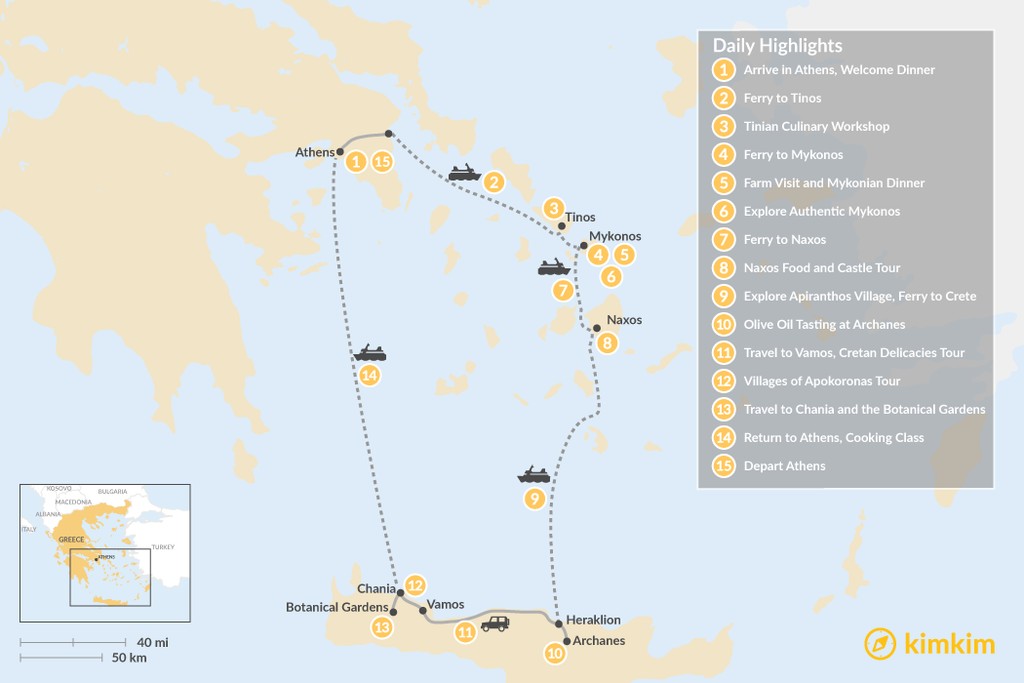Highlights
- Sip kitron at a Naxian distillery
- Visit a working olive grove
- Tour the historic villages of Apokoronas
- Experience a Cretan dance performance at the Botanical Gardens
Brief Itinerary
| Day | Highlights | Overnight |
|---|---|---|
| Day 1 | Arrive in Athens, Welcome Dinner | Athens |
| Day 2 | Ferry to Tinos | Tinos |
| Day 3 | Tinian Culinary Workshop | Tinos |
| Day 4 | Ferry to Mykonos | Mykonos |
| Day 5 | Farm Visit and Mykonian Dinner | Mykonos |
| Day 6 | Explore Authentic Mykonos | Mykonos |
| Day 7 | Ferry to Naxos | Naxos |
| Day 8 | Naxos Food and Castle Tour | Naxos |
| Day 9 | Explore Apiranthos Village, Ferry to Crete | Archanes |
| Day 10 | Olive Oil Tasting at Archanes | Archanes |
| Day 11 | Travel to Vamos, Cretan Delicacies Tour | Vamos |
| Day 12 | Villages of Apokoronas Tour | Vamos |
| Day 13 | Travel to Chania, Dinner and Traditional Dancing at the Botanical Gardens | Chania |
| Day 14 | Return to Athens, Cooking Class | Athens |
| Day 15 | Depart Athens |
Detailed Itinerary
Day 1: Arrive in Athens, Welcome Dinner
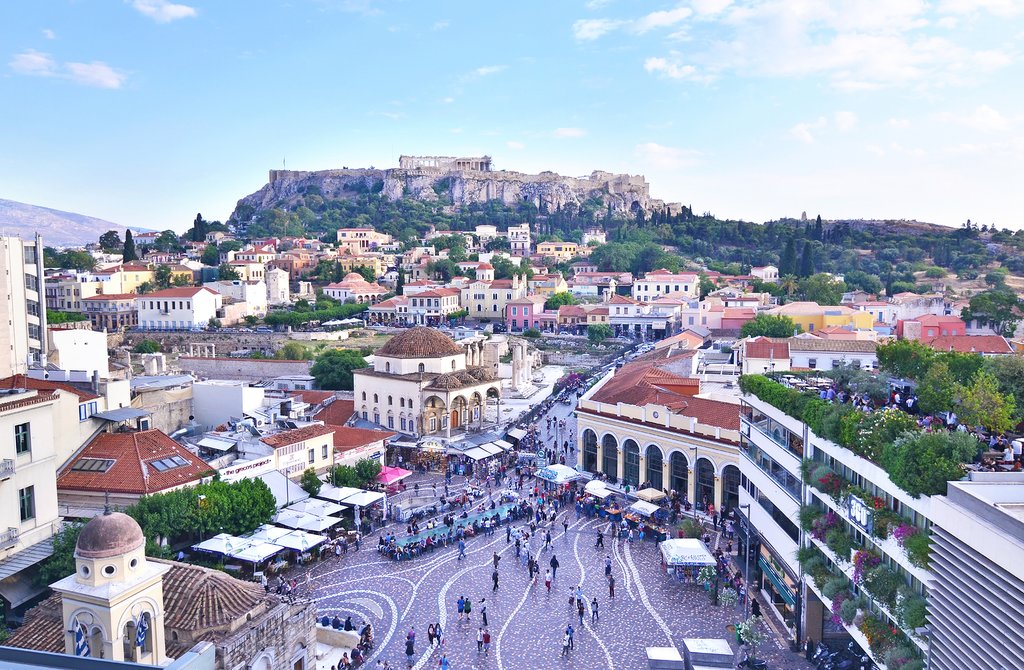
Welcome to Greece! You'll begin your trip in Athens, home to both the iconic Acropolis and so much more. The mythology of this spectacular city precedes it, with towering temples to Classical deities and the ruins of ancient marketplaces rubbing shoulders with lively nightlife, crowded flea markets, and contemporary cuisine. Make the most of your time in the city at some of these spots:
- Check out the views of the can't-miss Parthenon. (Pro tip: The Parthenon is the temple, the Acropolis is the hill.) This temple to Athena has enchanted visitors since its construction was completed in 438 BC. It's probably the first thing that comes to your mind when you think of ancient Greece and is visible from many of the city's high points.
- Stop at the sprawling National Museum for a crash course in ancient iconography. Be sure to seek out the room housing the Antikythera mechanism, essentially an ancient astronomical computer.
- Visit a smaller archaeological site at the Tower of the Winds, then stroll down neighboring pedestrian Aiolou Street to stop at shops and cafes.
- Find your perfect souvenir or sun hat in the busy stalls of the Monastiraki flea market.
In the evening, you'll sit down to enjoy either a welcome dinner with views of the Acropolis or wine tasting in a bar in downtown Athens.
Day 2: Ferry to Tinos

Take an early ferry to Tinos, one of the most overlooked islands of the Cyclades. Tinos has remained under the radar for many years, overshadowed by its celebrity neighbor of Mykonos and seen mainly as a religious destination. Those who continue to believe that, however, are missing out on an island with fascinating history and culture, winding streets, great outdoor activities, and glittering beaches.
The imposing Panagia Evangelistria should not be overlooked, as Tinos is also known as the island of the Virgin Mary. Its icon is believed to have healing powers, and the annual August pilgrimage is a key part of the island's identity as churchgoers crawl on their knees toward the temple as a sign of piety.
If pilgrimage isn't quite your scene, there are also nearly 80 windmills to be explored, Venetian ruins, hiking at Exomvourgo mountain, and beaches for any moods. Try the island's craft beer from Nissos brewery or sample the cheeses at the shop belonging to the Cheese Cooperative of Tinos. Keep an eye out for the many painted dovecotes around the island as well, small white pigeon homes dotting the countryside of which there are nearly 1,000.
Day 3: Tinian Culinary Workshop
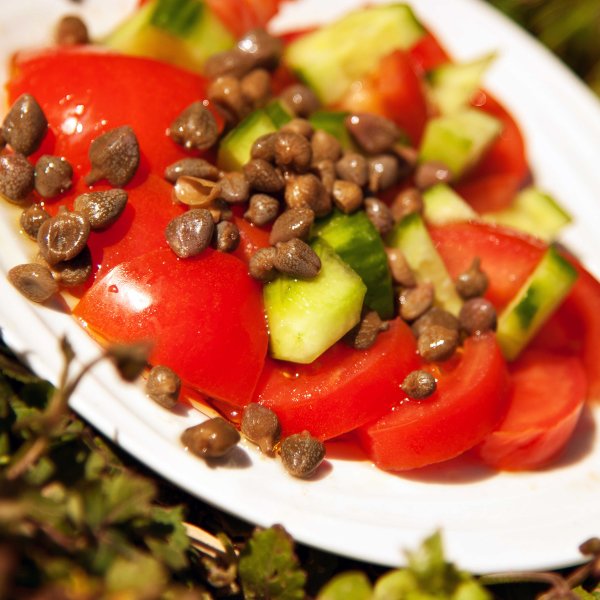
Visit an aromatic garden and harvest fresh ingredients as part of this culinary experience. You'll learn the stories of some Greek recipes, then cook them yourself with expert instruction. Enjoy the fruits of your labor al fresco, as you consume your creations under the trees and arched alleyways accompanied with local wines and the scent of the herb garden.
Spend your evening in the main Tinos town and take advantage of the many cafes and tavernas along the seaside or in the interior. Complete your island culinary education with louza, a cured pork that's been refined by Tinians over years of practice, and rich volaki cheese balls and kariki cheese aged within pumpkin skins, similar to a stilton or roquefort. See if the menus offer fourtalia, a fresh Cycladic dish similar to an omelette made with fresh local eggs, sausage, and potatoes, or dishes made out of the signature Tinian artichokes. Complement them with a glass of crisp, light Tinian wine or Nissos beer brewed right on the island.
Day 4: Ferry to Mykonos

You'll take a ferry in the morning to Mykonos, one of the most famous islands in the Cyclades. Known for its glitzy restaurants and nightlife, art scene, and jet set crowds (it was recently home to a Gucci pop-up boutique), Mykonos is one of the most quintessential Greek isles.
Your first day's itinerary is up to you. You'll receive a personalized list of tips for exploration, but some highlights include:
- If you need to get your toes in the sand immediately, head to remote Agios Sostis beach to find your own isolated paradise.
- For a more active experience, Ftelia Beach is known for its excellent windsurfing.
- Stroll through Little Venice, an 18th-century neighborhood where colorful former captains' mansions and seaside restaurants seem to sprout straight from the sea. It's also right next to the island's famous hillside windmills for great photo ops.
Day 5: Farm Visit and Mykonian Dinner

The morning is yours to explore, so head to a beach to lounge or stroll through the cosmopolitan streets, scoping out the boutiques that draw the island's stylish crowd season after season.
In the afternoon, you'll pay a visit to a traditional farm. Talk to the farm's caretakers to learn about how vegetables are grown on the islands and how the livestock are raised, and even say hi to the animals.
As the sun begins to set, you'll sit down to a traditional dinner. You'll be welcomed into a local Mykonian household for the meal, where you'll experience the traditional Greek way of life, culture, and cooking. Hear all about their stories of the island's culture and history as well as their own family history, over authentic dishes and free-flowing local wine (for the older crowd).
Chat with a local specialist who can help organize your trip.
Day 6: Explore Authentic Mykonos

Today, you'll sneak away from the cosmopolitan side of this island to discover Mykonos' authentic heart, touring charming villages, little harbors, and remote beaches with your expert guide. You'll start with a panoramic viewpoint of Mykonos Town to capture the perfect 360 degree shot. Then, head to the port of Agios Ioannis, a protected harbor where fishing boats now launch. Hear the stories of its namesake saint, including a church dedicated to him and the cell he was held in that are now home to an annual festival.
Next, you'll go through the island's agricultural and livestock country, past cultivated fields and animals grazing. At Ano Mera village, you'll explore a farm with its superintendent and even have the opportunity to help out with some farm work or say hi to the animals. You'll also sample a light lunch with products grown right there in the fields. After lunch, the colorful village square awaits, including a monastery tour and stroll through the open-air market.
From there, the shores of Kalo Livadi, Kalafati, and Aghia Anna all await your camera lens as you pass them on your way to learn about the island's history at the site of former mines. The now-abandoned structures used to mine lignite from the island's soil. Wrap your tour up on the picturesque narrow streets of Mau, home to the Mykonos dam.
The evening is yours to spend as you will, whether you want to relax by the sea, wind away the hours with a sundowner in Little Venice, or dance the night away on the boardwalk of Paradise Beach.
Day 7: Ferry to Naxos

Time to ferry over to bustling Naxos after breakfast. With an active main town where you can shop and admire the Venetian architecture, a historic Kastro (castle) area, and expansive beaches, the island offers opportunities for both laidback relaxation, as well as water or land activities. The rest of the day is yours to unwind as you choose. Try out some of these options:
- Hike up to the summit of Mount Zas, the mythological childhood home of Zeus, the ruler of the gods, and the highest point in the Cyclades.
- Head inland to the town of Chalki, home to the island's oldest market and a petite, shady square perfect for whiling away the afternoon. Stop at the kitron distillery to sample the local liqueur and learn about its distillation process over the years.
- Visit the Temple of Demeter at Sangri on your way. Multiple deities of fertility were worshipped here, particularly the goddess Demeter. The temple was constructed in 530 BC, during the tyranny of Lygdamis, and represents a precursor of classical Athenian architecture.
- Stroll to the Portara, the entrance to the Temple of Apollo. Construction on the temple began in the sixth century BCE but was never finished, but the still-standing entranceway has become one of the hallmarks of the island. You can find it on the islet of Palatia, just over a causeway from the heart of Naxos Town (Chora).
For dinner, wander up the hill through the streets of the Kastro neighborhood to pick out your favorite of the area's tavernas, where you can sample the island's fresh produce in its best forms.
Day 8: Naxos Food and Castle Tour

As the largest island in the Cyclades, Naxos is home to a wide range of agriculture in addition to its tourist industry. Livestock live alongside the western farms, home to the famous Naxian potatoes, and mountainous areas full of olive groves provide the staples of Greek cooking.
Your guide will take you through winding lanes of the main Naxos town to sample some of the products of those fields. You'll sample five different Naxian cheeses along with kitron, a traditional liqueur distilled on the island. You may also stop at a candy shop and learn about confectionary production or visit a wine shop to taste Greek varietals. Then, continue on to a historic tour of the Venetian Castle.
Spend the evening continuing to wander the Castle district and put your newfound knowledge to use in the many tavernas on the hillside. For great views over the town and across to neighboring Paros, check out 1739 Terrasse Cafe.
Day 9: Explore Apiranthos Village, Ferry to Crete

Today, you'll have an opportunity to travel to the village of Apiranthos. This fantastical spot is situated at the foot of the Fanari Mountain, the island's third-highest peak. Also known as the Marble Village, its winding streets and traditional architecture have been nearly untouched since the days of the Venetians, as has its language. The local dialect is believed to contain both ancient Greek and Byzantine elements.
Most of the village can only be accessed on foot. Have a coffee on the pedestrian-only main street and soak in a slower pace of life, and get lost in the village's winding pathways that crawl up and down the mountainside. Don't miss a visit to the nearby Agia Kyriaki church, located within hiking distance beyond the village. This former Byzantine church is best known for the remnants of its historic murals.
In the afternoon, you'll catch a ferry to Crete, the largest and most populous of the 230 inhabited Greek islands, and its capital city of Heraklion. Once there, you'll be transferred to the village of Archanes.
Day 10: Olive Oil Tasting at Archanes

Olive oil is one of the keystones of Greek cuisine, and you'll get a hands-on look at its process with today's tour. Visit an olive farm and olive oil mill to learn about the many facets of olive harvesting, including the key role of timing and various harvesting methods. Taste the oil while you hear the stories of the owners of this family business and learn about the many uses of this ingredient.
The village of Archanes is also known for its raki, a traditional Cretan grape-based spirit used a welcome gesture for guests, appetizer, digestif, and more. If you're in town during harvest season, don't miss the kazanamata feast to celebrate the first raki of the season.
Day 11: Travel to Vamos, Cretan Delicacies Tour

This morning, you'll travel to the traditional village of Vamos after breakfast. Once you arrive, you'll meet the farmers and food specialists of Crete during a guided tour, exploring Vamos and the surrounding area to meet these creators and sample their products.
You'll start at the local olive oil factory, where you'll learn about its production process and sample some of the fresh oil, along with an explanation of what distinguishes Cretan virgin olive oil from other oils.
Next up, the local cheesemaker. Crete is known for its graviera cheese, a slightly sweet, hard sheep cheese. You may watch the expert on duty as he makes graviera and teaches you about the cheese-making process, with samples of different varieties including graviera, anthotyros, and myzithra. For the older participants, it's also time for your first raki of the day, a grape-based spirit that's also Crete's national drink.
Head to the 14th century Byzantine church of Saint Nicolas on your way to the next stop to take in its frescoes and architectural features. Afterward, you'll arrive in the village of Hiliomoudou, where one of the few hand producers of sheep and goat bells practices his craft. You can watch him work and learn how to distinguish between the sounds of sheep and goat bells while sipping your second raki.
End as you began at a second olive oil press, this time home to both the rarer organic olive oil and the elusive Cretan kri kri goats, a species only found on this island. See if you can spot them as you sit at the taverna and enjoy a traditional lunch with all the ingredients you've just observed.
Walk off all those samples with an afternoon stroll around Vamos, surrounded by local history and hospitality, before spending the night in your traditional guesthouse.
Day 12: Villages of Apokoronas Tour
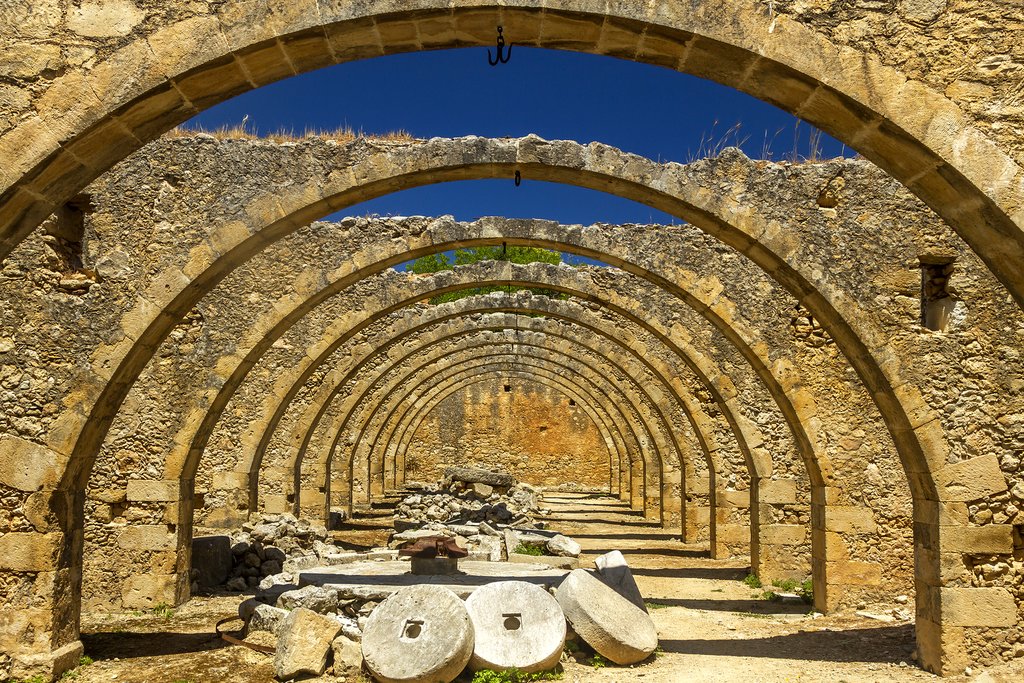
Today, you'll have a chance to hear some of the island's history firsthand during a guided tour through nearby Apokoronas. The region's villages—seven of them—are home to a number of sites including an Ottoman fort, historic churches, and a folklore museum. But most interesting will be the conversations you and your guide will have with the local residents of the area.
Some potential highlights include:
- The hillside ruins at ancient Aptera, one of the largest city-states in Crete until it was destroyed by an earthquake in the seventh century, including a Minoan tomb believed to date back to roughly the 13th century BCE.
- Two-aisled churches in Stilos village from the 13th and 15th centuries, along with a limestone fossil once believed to be a fossilized sea siren and a walk along the Kiliaris river to a Venetian watermill.
- A glassblowing factory in Kokkino Chorio.
- The old square of Gavolochori, where you can visit the women's cooperative and see hand-knit lace created using a Byzantine technique or the neighboring Folklore Museum of Gavalochori.
In the evening, take it slow amid the relaxed pace of village life back in Vamos.
Day 13: Travel to Chania, Dinner and Traditional Dancing at the Botanical Gardens

Spend your morning traveling to Chania, the second largest city in Crete and one of the most scenic spots on an island with stiff competition for that title. Life in this former Venetian city revolves around its charming 14th-century harbor, narrow streets with winding alleys, and colorful architecture influenced by past Ottoman and Egyptian eras.
Familiarize yourself with your new spot with some afternoon wanderings. In the evening, you'll be whisked off to the Botanical Park and Gardens for a celebratory feast. Start off with a tour around the park, taking in the lush foliage as you learn about local produce and the unique blend of Mediterranean, Alpine, and tropical climates found in Crete. Once you've worked up an appetite, sit down to enjoy a Cretan dinner created with produce fresh from the garden. Your meal will be accompanied by traditional music and dancing, complete with costumes.
Day 14: Return to Athens, Cooking Class

You'll head back to Athens in the morning after breakfast.
Once you've settled in, spend your afternoon acquiring some take-home skills with a cooking class. You'll visit a contemporary multi-use space home to four shops in one—a coffee house, pie shop, creamery, and kitchenette—and the perfect setting for your lesson. Discover local products from around Greece and experiment with traditional recipes to create your own twist on the classics. And, of course, sample all of it. Savor the fruits of your labor on the rooftop while taking in views of the Acropolis and surrounding Plaka neighborhood.
The evening is yours to spend as you will, whether you want to sneak in some last-minute souvenir shopping in Monastiraki or visit the wine bars of Koukaki for an end-of-trip toast.
Day 15: Depart Athens
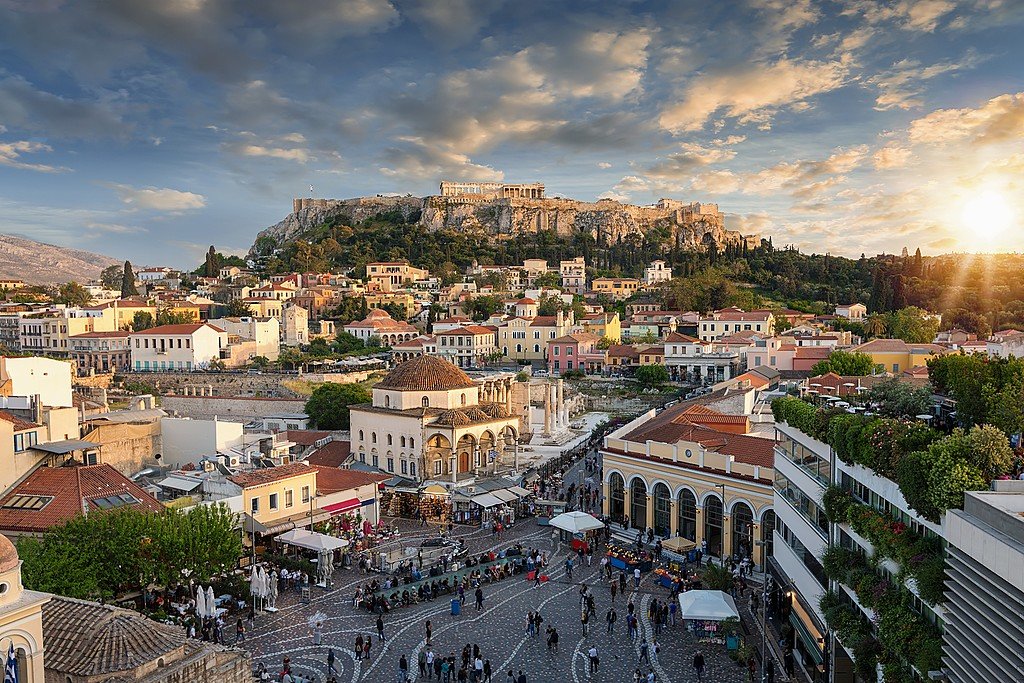
Time to say farewell to Greece. Enjoy your final Athenian breakfast and sneak in some last-minute exploring before your transfer to the airport.


